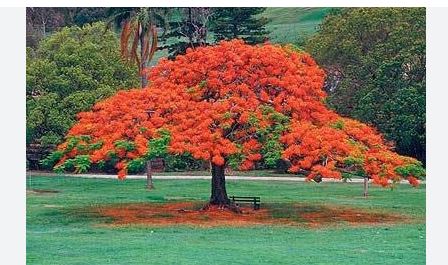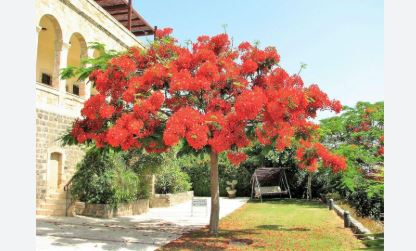
Botanical Classification
The Royal Poinciana, scientifically known as Delonix regia, belongs to the Fabaceae family, commonly called the legume, pea, or bean family, placing it in the same family as Cassia fistula. It is classified under the genus Delonix, which includes other tropical flowering trees, and the species name regia (Latin for “royal”) reflects its majestic appearance.
The tree is part of the subfamily Caesalpinioideae, characterized by showy flowers and pinnate leaves. Unlike some legumes, Delonix regia is not a significant nitrogen-fixer, but its vibrant blooms and wide canopy make it a standout ornamental species. Its taxonomic synonyms include Poinciana regia, reflecting earlier classifications. This botanical positioning highlights its adaptation to tropical and subtropical environments, making it a favorite for warm-climate landscaping.
Native Area and Distribution
Delonix regia is native to Madagascar, specifically the dry deciduous forests of the western and southern regions, where it grows in well-drained soils at low elevations. In its native habitat, it is considered near-threatened due to deforestation and habitat loss, with limited natural populations remaining. However, the tree has been widely cultivated and naturalized across tropical and subtropical regions globally, including India, Southeast Asia, the Caribbean, Central and South America, Australia, Africa, and southern parts of the United States (e.g., Florida, Hawaii).
It thrives in countries like Brazil, Mexico, Thailand, and the Philippines, often planted as an ornamental in parks, streets, and gardens. In some regions, such as parts of Australia and South Florida, it can self-seed and become mildly invasive, though less aggressively than some other species. By 2025, its global distribution continues to expand due to its popularity, but conservation efforts in Madagascar focus on protecting its native populations.
History

The Royal Poinciana has a rich history tied to its stunning beauty and cultural significance. Discovered in Madagascar in the early 19th century by botanist Wenceslas Bojer, it was named Poinciana regia in honor of Phillippe de Longvilliers de Poincy, a 17th-century governor of the French Caribbean islands who was an avid plant enthusiast.
The tree’s vibrant red-orange flowers earned it names like Flamboyant (French for “flaming”), Flame Tree, and Peacock Flower in various regions. It became a global ornamental staple through colonial trade and botanical exchanges, spreading to tropical regions by the late 19th century. In India, it is a symbol of summer, often planted alongside Cassia fistula for contrasting red and yellow blooms.
In Thailand and Vietnam, it is celebrated in festivals and poetry for its fiery appearance. In Brazil, it is called Árvore de Fogo (Fire Tree) and is a common sight in urban landscapes. By 2025, Delonix regia remains a cultural icon, featured in tropical garden designs and eco-tourism initiatives, with its seeds and wood historically used for crafts and traditional medicine in some cultures, though its primary value is ornamental.
USDA Zones
Delonix regia thrives in USDA Hardiness Zones 10–12, where temperatures rarely drop below 30°F (-1°C). It is best suited to tropical and subtropical climates with warm, humid summers and mild winters. In the United States, it flourishes in South Florida, Hawaii, Southern California, and parts of Arizona and Texas, where frost is minimal.
In Zone 9b, it may survive with protection (e.g., frost blankets) but often experiences die-back or reduced growth. The tree is sensitive to temperatures below 28°F (-2°C), which can damage young trees or kill mature ones. In 2025, gardeners in borderline zones (e.g., 9a) can grow it in containers and move them indoors during cold snaps, leveraging smart climate-control systems to extend its range. For optimal flowering, it requires a hot, dry season followed by a wet season, mimicking its native Malagasy climate.
Growth Rate
Delonix regia is a fast-growing tree, typically adding 3–5 feet per year under ideal conditions (full sun, well-drained soil, and ample water during establishment). Seedlings can reach 10–12 feet within 2–3 years, and mature trees attain heights of 30–40 feet (9–12 meters) with a canopy spread of 40–60 feet in 10–15 years.
Growth is fastest in tropical climates with distinct wet and dry seasons, slowing in cooler or consistently humid conditions. Flowering typically begins 3–5 years after planting for seed-grown trees, with peak bloom intensity in mature specimens. The use of organic fertilizers and smart irrigation systems can accelerate growth, but overwatering or poor drainage can stunt development. The tree’s rapid growth makes it ideal for quickly establishing shade or visual impact in landscapes, though its wide canopy requires ample space.
Identifying Characteristics
Delonix regia is a deciduous or semi-evergreen tree, depending on climate, growing to 30–40 feet tall (9–12 meters) with a wide, umbrella-shaped canopy spanning 40–60 feet. Its trunk is smooth and grey when young, becoming rougher and darker with age, often reaching 1–2 feet in diameter. The leaves are bipinnate, fern-like, and 12–20 inches long, with 20–40 pairs of small, bright green leaflets (0.5–1 inch long), giving a feathery, tropical appearance.
The tree is briefly leafless during the dry season, enhancing its floral display. Its flowers are the defining feature, appearing in late spring to summer (May–July in the Northern Hemisphere) in large, loose clusters. Each flower is 4–5 inches wide, with five petals (four bright red or orange-red, one larger petal with yellow and white streaks, called the “standard”).
The fruit is a flat, woody seedpod, 12–24 inches long and 2 inches wide, dark brown to black, containing 20–40 hard, toxic seeds. The tree’s vibrant blooms and wide, shady canopy make it unmistakable in tropical landscapes.
Landscape Uses
- Specimen Tree: The fiery red-orange blooms and wide canopy make it a stunning focal point in large gardens, parks, or estates. Its brief leafless period during flowering enhances its visual impact.
- Shade Tree: The broad, umbrella-like canopy provides ample shade, ideal for patios, courtyards, or public spaces like campuses and resorts.
- Street and Avenue Planting: Frequently used along boulevards or medians in tropical cities (e.g., Miami, Rio de Janeiro), often paired with Cassia fistula for contrasting colors. Its wide canopy requires spacious planting strips (6–8 feet or wider).
- Parking Lot Islands: Suitable for large parking lot islands (>200 sq ft) due to its drought tolerance and shade production, enhancing urban aesthetics.
- Biodiversity Support: Flowers attract bees, butterflies, and hummingbirds, while seedpods draw seed-eating birds, boosting local ecosystems.
- Coastal Landscaping: Tolerates moderate salt spray, making it suitable for coastal gardens in places like South Florida or the Caribbean.
- Cultural and Event Spaces: Planted in festival grounds or near landmarks for its symbolic “flamboyant” beauty, especially in tropical regions.
- Erosion Control: The deep root system stabilizes soil, making it useful in reclamation projects or sloped landscapes.
Cultivation
Site Selection
- Climate: Best in USDA Zones 10–12, thriving in warm, humid summers and mild winters. Protect from frost in Zone 9b using blankets or container planting.
- Sunlight: Requires full sun (6–8 hours daily) for maximum growth and flowering. Avoid shaded or partially shaded locations.
- Soil: Prefers well-drained soils, including sandy, loamy, or slightly alkaline soils (pH 5.5–7.5). Tolerates poor soils but not waterlogging.
Propagation
- Seeds: The primary method. Seeds have a hard coat, requiring scarification (soaking in hot water for 24 hours or abrading with sandpaper) to improve germination. Sow in spring at 70–80°F (21–27°C). Germination takes 7–14 days, with seedlings transplantable after 6–12 months.
- Cuttings or Grafting: Less common but faster for flowering (2–3 years vs. 3–5 for seeds). Use semi-hardwood cuttings or graft onto rootstock for specific traits.
- Sourcing: Obtain seeds or saplings from reputable nurseries like Urban Tropicals or Top Tropicals, ensuring suitability for your climate.
Planting
- Spacing: Space trees 20–30 feet apart to accommodate the 40–60-foot canopy. Stake young trees to support against wind and encourage straight growth.
- Method: Dig a hole twice as wide and as deep as the root ball. Mix soil with compost for nutrients. Plant at the same depth as the nursery pot, water thoroughly, and mulch to retain moisture.
- Container Planting: In cooler zones, grow in large pots (15–20 gallons) for mobility, moving indoors during winter.
Maintenance
- Watering: Water regularly during the first 1–2 years to establish roots (2–3 times weekly). Once established, it is drought-tolerant, needing occasional deep watering in dry seasons. Avoid overwatering to prevent root rot.
- Fertilization: Apply a balanced fertilizer (e.g., 10-10-10) in spring and early summer to boost growth and flowering. Use organic options like compost or fish emulsion for sustainability.
- Pruning: Prune young trees after flowering to shape the canopy and remove low, drooping branches. Mature trees need minimal pruning, mainly to remove deadwood or maintain clearance for streets (10–12 feet above ground). Pruning is best in late summer to avoid stress during bloom season.
- Pest and Disease Control: Generally pest-resistant but susceptible to scale insects, spider mites, or fungal leaf spots in humid conditions. Use neem oil or insecticidal soap for pests and ensure good air circulation to prevent fungi. In 2025, apps like Plantix can diagnose issues via photos.
- Debris Management: Rake fallen seedpods and leaves regularly, as they can be messy in urban settings or near pools.
Growth and Flowering
- Growth Timeline: Reaches 10–15 feet in 2–3 years and 30–40 feet in 10–15 years. Flowering begins at 3–5 years, peaking in mature trees.
- Flowering Season: Blooms in late spring to summer (May–July in the Northern Hemisphere), with vibrant red-orange flowers lasting 4–6 weeks. A distinct dry season enhances bloom intensity.
- Challenges: Weak branches may break in high winds, so avoid exposed sites. Frost damage in Zone 9b can kill young trees or reduce flowering.
Gardening Trends
- Smart Technology: Use soil moisture sensors (e.g., Govee) or smart irrigation systems like Rachio to optimize watering, especially in arid climates. Apps like Planta can track care schedules.
- Sustainable Practices: Mulch with organic materials to conserve water, and plant near herbs like rosemary or thyme to create a pollinator-friendly garden. In 2025, Delonix regia is popular in urban greening projects for its shade and air-purifying qualities.
- Climate Adaptation: In hotter climates, provide afternoon shade for young trees to reduce heat stress. In coastal areas, leverage its salt tolerance for beachside planting.
- Container Gardening: For small spaces or cooler zones, grow in large containers with wheels for mobility, using LED grow lights indoors during winter.